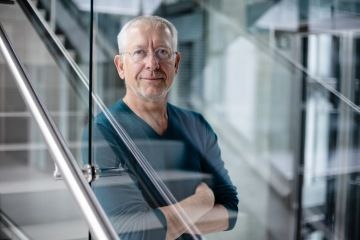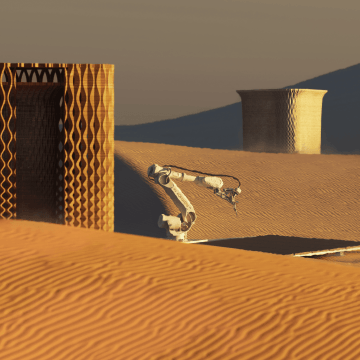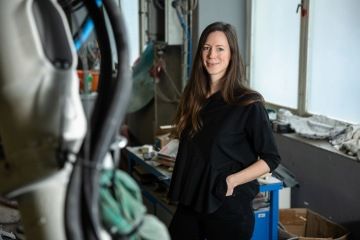
Ladislav Bartoníček’s journey to So Concrete was driven by his passion for art and a long-standing friendship with artist Federico Díaz. What motivated this prominent figure from the PPF Group to invest in the company and contribute to its further development? “The combination of cutting-edge material and technology is highly appealing. Additionally, high quality and aesthetics are key factors,” explains investor Ladislav Bartoníček.
Share article
You are known for your appreciation of art. What drew you to it?
It developed gradually. From the mid-1990’s, I cautiously started with graphic art, simply because I was drawn to those pieces. Then I became interested in auctions, and over time, it subtly accumulated like a snowball effect.
Did you have a guide in the early days? How did you navigate the art world?
I would say it was primarily guided by my personal taste. Although it’s true that we worked closely with Petr Dvořák, who ran a company dealing with economic analyses as well as annual reports, which led us to naturally discuss graphic design and related topics. Beyond that, I navigated the art world mostly on my own.
Could you name a favorite artist or art movement?
The field is so vast that it’s incredibly difficult to single out a few names or even just one. I thought it would be useful to narrow down the scope, so I spent a considerable amount of time focusing on Czech art from the 1950’s, including figures like Karel Malich, Věra Janoušková, and Václav Boštík. Currently, though, I am much more focused on emerging young artists.
Do you primarily focus on the Czech art scene, or does your interest extend to international art as well?
When I’m abroad and come across something worth seeing, I take a look, but fundamentally, I concentrate on the Czech scene. This is because it’s somewhat manageable and comprehensible. Expanding further becomes more complex.
Do you view art as an investment?
No, I don’t approach art primarily as an investment. I see it as something that resonates with me, something I genuinely appreciate. I don’t fundamentally think about whether a particular sculpture or painting will increase in value. Investing in international art without deep knowledge could mean losing a significant amount of money.
Do you have anything in your collection that particularly delights you or of which you are especially proud?
I have quite a few pieces by Karel Malich, who profoundly resonates with me. Given the extent of my collection, I am indeed quite proud of it.
Do you surround yourself with art at home as well?
Absolutely! My wife sometimes gets upset, saying that our home looks like a gallery. We also debate whether to change the art on display or keep it as it is.
And how do you feel about that?
Sometimes I don’t want to change it because I feel that everything is ideally placed where it is.
Has art served as a counterbalance to the world of business and numbers for you?
Definitely. Not in terms of the objects themselves, but rather in the people—artists and others involved in this sphere. They are incredibly intelligent individuals with a mindset quite different from those in business. It’s very pleasant and refreshing to in teract with them and discuss, as their priorities are so far removed from business that it’s quite enjoyable.
Now that you‘ve moved on from PPF, do you have more time to devote to art?
It hasn’t dramatically improved. There were times when I had virtually no time at all due to work and extensive travel. Now, it‘s more balanced, and I can find time for it.
"It’s not just about finding investment targets but also analyzing whether the business makes sense, if there is growth potential, and if it’s sufficiently unique."
How has your work pace changed? What are you currently focusing on the most?
The approach has changed in one key aspect: because I’m responsible for a much smaller entity now, I can better manage what I want to focus on and what I don’t. Essentially, there are fewer complications, which is pleasant. Together with JP Duvieusart, I’m involved in analyzing interesting investment projects and potentially investing in them. Doing this correctly involves quite a bit of work. It’s not just about finding investment targets but also analyzing whether the business makes sense, if there is growth potential, and if it’s sufficiently unique.
How would you apply this to So Concrete?
So Concrete is attractive to me because it offers a very interesting combination of cutting-edge technology and materials in an industry that is otherwise quite backward in terms of applying modern technology and materials. This represents a significant opportunity. Moreover, with Federico Díaz as the founder, there’s an added layer of high quality and aesthetics. Thus, I see a very intriguing combination where it’s not only interesting from a technical perspective but also in terms of its integration with art and aesthetics.
How did you discover So Concrete?
I’ve known Federico Díaz for quite a long time, possibly over fifteen years. We share similar values, became friends, and I discussed this project with him when he was just starting it. Later, we agreed it made sense for me to get involved.
You hold a one-third stake in the company. Does that mean you are more actively involved in its development? What is your role?
I am a member of the board of directors. We meet once a week to address both routine operational issues and questions about the company‘s future development. I am definitely quite engaged with So Concrete, more so compared to other projects.
You mentioned that the construction industry is relatively backward...
That’s not entirely accurate. It’s more that the implementation of new technology in construction is progressing very slowly compared to other fields.
What is causing this slow pace?
There isn’t a simple answer to that. It’s definitely influenced by the fact that construction is a highly traditional industry built on caution. When you look at various statistics on automation, construction still involves a huge amount of manual labor, and the speed of adopting new technology is incredibly slow compared to many other fields. This is likely due to the fact that construction has evolved over thousands of years, whereas other industries are much younger.
What potential for growth can you see for So Concrete?
This issue is global, not just limited to the Czech Republic. Our ambition is certainly to be competitive and to provide solutions on an international level. However, it’s important to first establish ourselves domestically, as mistakes made abroad can be more costly. Nevertheless, expanding internationally is definitely part of our plan.
What is the current situation in the Czech Republic? What is holding back potential?
It’s a combination of various factors. On the architects‘ side, it’s about willingness, knowledge, and a readiness to embrace certain risks and utilize new technologies. Similarly, developers and construction companies face similar challenges. At the same time, there is bureaucracy, such as various certifications and regulations, that can impede progress. However, the situation is changing, and one of So Concrete’s goals is to raise awareness as much as possible, so that the use of the technology and materials we offer gradually increases.
Can new technologies advance the construction industry?
Yes, it’s crucial to recognize that construction is one of the largest producers of CO2 in terms of carbon footprint. Robotic printing and additive technologies have a significant advantage in this regard, as they optimize material usage, thereby reducing the carbon footprint. This is a critical factor for the future. This trend will gradually compel developers to use new materials and technologies more extensively, not just for structural elements, but also for facades and other components.
How large should the company be in five years?
That’s relatively far off, but for it to make sense, So Concrete should aim to achieve revenues in the billions of Czech crowns, definitely over one billion. As for profitability, it’s diffi cult to say precisely, but a margin between ten and twenty percent seems reasonable.
Have you discovered anything else interesting about So Concrete over time, or has anything surprised you?
The material possibilities are certainly intriguing. We focus primarily on ultra-high-performance concrete (UHPC), but there are various ways to further innovate with UHPC, such as using different recyclables or combining UHPC with other materials to enhance additional properties. The deeper we delve into this issue, the more fascinating it becomes.
Can you provide an example?
It’s not just about having a material that can be printed, but also about ensuring it has optimal properties, such as insulation, to improve the energy balance of buildings where our materials are used.
Another aspect is that So Concrete is not just about a printer using concrete as a medium; it’s also about exploring various methods of robotic fabrication. We experiment and create different elements not only through printing but also using other techniques, such as milling, which can model various shapes.
Currently, we mostly use a robot with an arm that creates a kind of “caterpillar” from which structures are built. However, there are other technologies that might achieve even more complex shapes, and that is an other exciting area we are exploring.
Share article
More news
So Concrete at Timber Square: Concrete meets low-carbon innovation in the heart of London
We’re proud to be part of Timber Square, Landsec’s landmark sustainable development in the heart of Bankside, London. Here we’ve created a set of high-performance concrete (HPC) elements, including four large-scale planters for trees and a multi-functional planter-bench system that helps shape the public realm.
Not Science Fiction — Report from the So Concrete Workshop
So Concrete is a pioneer in robotic fabrication technology in the Czech Republic, which in recent years, has been gaining momentum around the world.
Process for Digital Concrete
Façade tiles, columns, interior accessories, wall cladding, as well as entire buildings - all of this is produced by So Concrete using robotic fabrication for clients from the ranks of developers, architects, construction companies or private investors.


